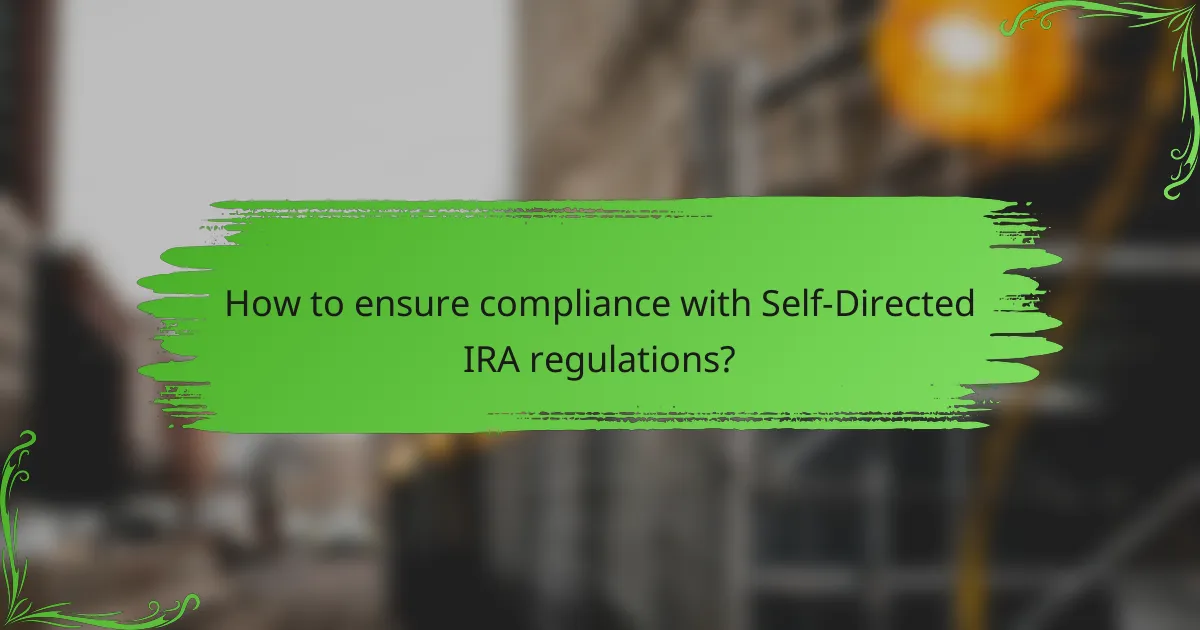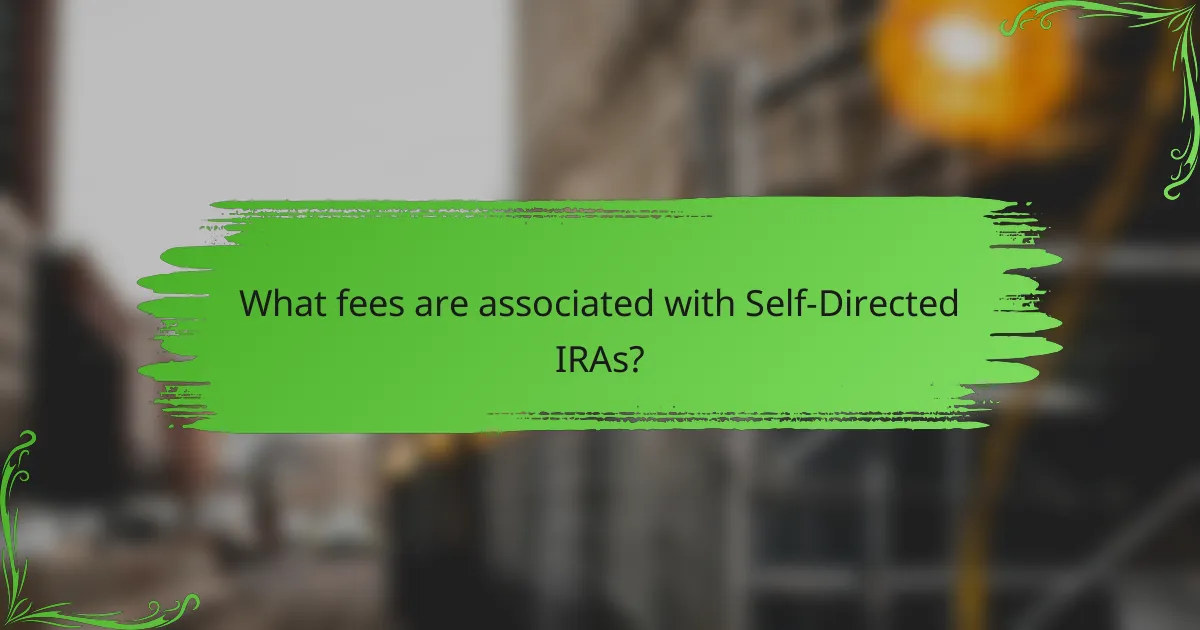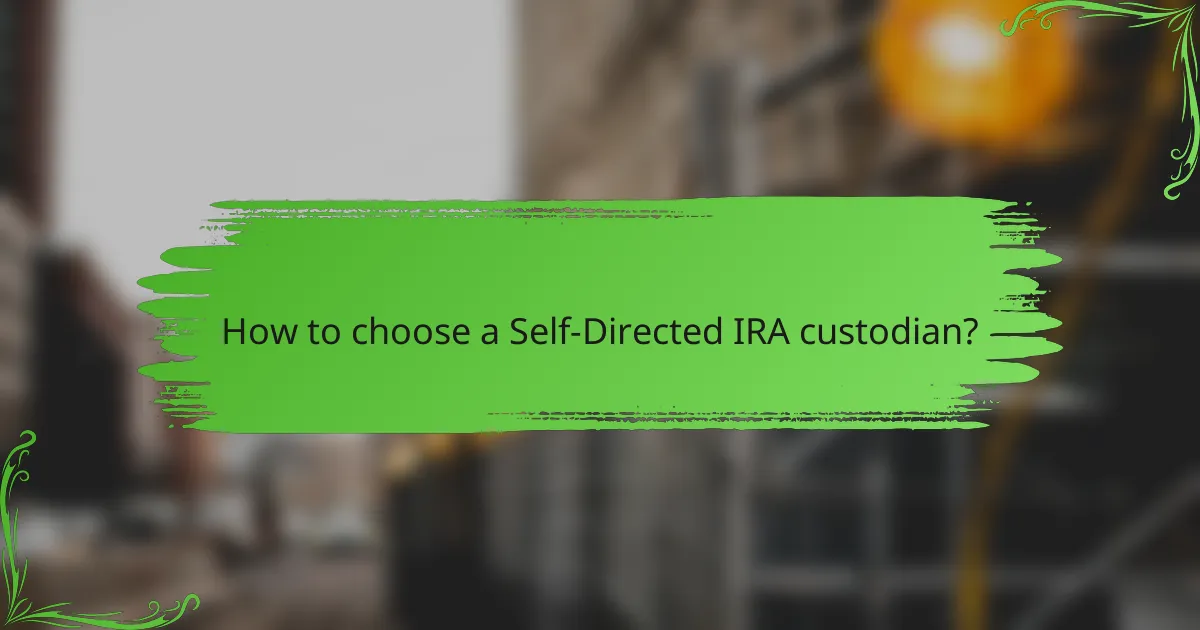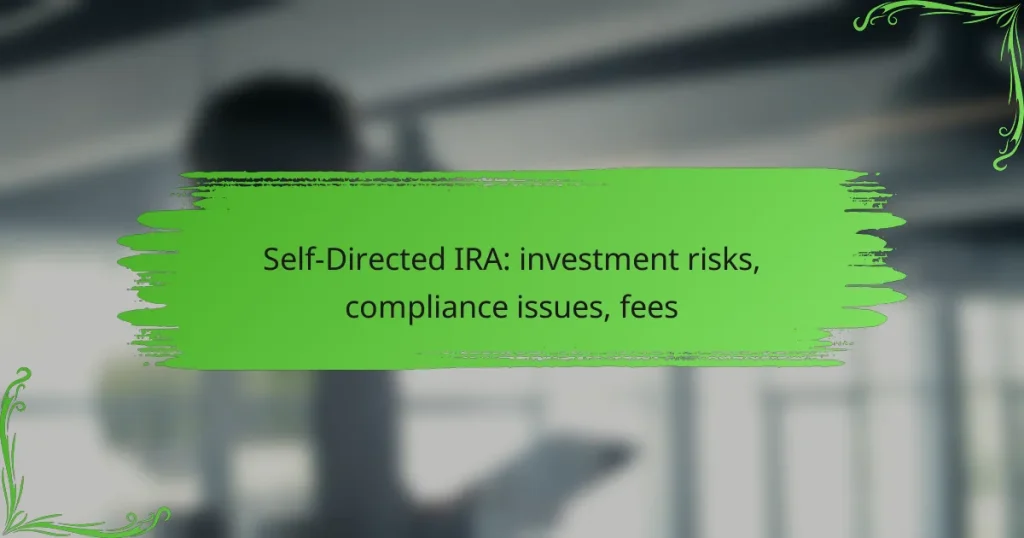Self-Directed IRAs provide investors with the flexibility to explore diverse investment options, but they also entail significant risks, including market volatility and potential fraud. Compliance with IRS regulations is essential to avoid prohibited transactions and ensure proper reporting, making the role of a qualified custodian invaluable. Additionally, being aware of the various fees associated with these accounts is crucial for effective financial planning and maximizing investment returns.

What are the investment risks of a Self-Directed IRA?
Self-Directed IRAs offer unique investment opportunities but come with significant risks. Investors must be aware of market volatility, asset liquidity, potential fraud, lack of diversification, and regulatory changes that can impact their retirement savings.
Market volatility impact
Market volatility can significantly affect the value of assets held in a Self-Directed IRA. Investments in real estate, private equity, or other non-traditional assets may experience sharp price fluctuations, leading to potential losses. It’s crucial for investors to assess their risk tolerance and consider how market conditions might impact their portfolio.
Illiquidity of assets
Many assets within a Self-Directed IRA, such as real estate or private placements, can be illiquid, meaning they cannot be easily sold or converted to cash. This lack of liquidity can pose challenges, especially if funds are needed for other investments or expenses. Investors should plan for potential cash flow needs and consider maintaining some liquid assets within their IRA.
Fraud and scams
Self-Directed IRAs can be targets for fraud and scams, particularly due to the less regulated nature of certain investments. Investors should conduct thorough due diligence on any investment opportunities and be wary of offers that seem too good to be true. Utilizing reputable custodians and seeking professional advice can help mitigate these risks.
Lack of diversification
Investing heavily in a limited number of assets can lead to a lack of diversification in a Self-Directed IRA, increasing overall risk. A concentrated portfolio may be more vulnerable to market downturns. Investors should aim to diversify across different asset classes to spread risk and enhance potential returns.
Regulatory changes
Regulatory changes can impact the types of investments allowed within a Self-Directed IRA and the tax implications of those investments. Staying informed about IRS regulations and potential changes is essential for compliance and to avoid unexpected tax liabilities. Consulting with a tax advisor or financial planner can provide guidance on navigating these regulations effectively.

How to ensure compliance with Self-Directed IRA regulations?
To ensure compliance with Self-Directed IRA regulations, investors must understand the IRS rules governing these accounts, avoid prohibited transactions, and adhere to specific reporting requirements. Engaging a qualified custodian can also help navigate these complexities effectively.
Understanding IRS rules
The IRS has established clear guidelines for Self-Directed IRAs, which include permissible investments and account management practices. Investors should familiarize themselves with these rules to avoid penalties or disqualification of their IRA. Key areas include the types of assets allowed, such as real estate, precious metals, and private placements.
Additionally, it’s crucial to understand the contribution limits and distribution rules set by the IRS. For instance, annual contributions are typically capped at a few thousand dollars, depending on the investor’s age and account type.
Prohibited transactions overview
Prohibited transactions can lead to severe penalties and the potential disqualification of the IRA. Common prohibited transactions include buying property for personal use, lending money to disqualified persons, or engaging in transactions with family members. Understanding these restrictions is vital for maintaining compliance.
Investors should regularly review their investment activities to ensure they do not inadvertently engage in prohibited transactions. Keeping detailed records and seeking professional advice can help mitigate risks associated with these rules.
Reporting requirements
Self-Directed IRA holders must comply with specific reporting requirements to the IRS, including filing Form 5498 annually. This form reports contributions, rollovers, and the fair market value of the account. Failure to file can result in penalties.
Additionally, if there are any distributions from the IRA, Form 1099-R must be filed to report those transactions. Staying on top of these reporting obligations is essential for avoiding fines and ensuring the account remains in good standing.
Using a qualified custodian
Engaging a qualified custodian is critical for managing a Self-Directed IRA. A custodian helps ensure compliance with IRS regulations, handles transactions, and maintains necessary records. Choosing a custodian with experience in Self-Directed IRAs can provide peace of mind and reduce the risk of errors.
When selecting a custodian, consider their fees, services offered, and reputation. Some custodians may charge a flat fee, while others may have variable fees based on transaction volume or asset type. It’s advisable to compare several custodians to find one that aligns with your investment strategy and budget.

What fees are associated with Self-Directed IRAs?
Self-Directed IRAs come with various fees that can impact your investment returns. Understanding these fees is crucial for effective financial planning and ensuring compliance with IRS regulations.
Account setup fees
Account setup fees are one-time charges incurred when establishing a Self-Directed IRA. These fees typically range from $50 to a few hundred dollars, depending on the custodian and the complexity of the account.
It’s important to compare different custodians to find the best setup fee structure that aligns with your investment strategy. Some custodians may waive this fee if you maintain a minimum balance.
Annual maintenance fees
Annual maintenance fees are recurring charges for the ongoing administration of your Self-Directed IRA. These fees usually range from $100 to $300 per year, depending on the custodian and the services provided.
Be aware that some custodians may offer tiered pricing based on the account balance, which could affect your overall costs. Always inquire about what services are included in these fees.
Transaction fees
Transaction fees apply each time you buy or sell an investment within your Self-Directed IRA. These fees can vary widely, typically ranging from $5 to $50 per transaction, depending on the custodian.
Consider how frequently you plan to trade when evaluating transaction fees, as high-frequency trading can significantly increase your overall costs. Look for custodians that offer lower fees for frequent transactions.
Custodial fees
Custodial fees are charged by the financial institution that holds your Self-Directed IRA assets. These fees can be flat-rate or based on the value of your investments, often ranging from 0.25% to 1% of assets under management annually.
When selecting a custodian, assess their custodial fee structure in relation to the services they provide. Some custodians may offer additional services, such as access to investment education or market research, which can justify higher fees.

What are the prerequisites for opening a Self-Directed IRA?
To open a Self-Directed IRA, you must meet specific eligibility criteria, provide required documentation, and choose an initial funding option. Understanding these prerequisites will help ensure compliance and facilitate the investment process.
Eligibility criteria
To qualify for a Self-Directed IRA, you must be an individual who is at least 18 years old and has earned income. Additionally, you cannot have any disqualified persons involved in the account, such as immediate family members or certain business partners.
It’s essential to ensure that you are eligible to avoid complications with the IRS. If you have previously contributed to a traditional or Roth IRA, you may still be eligible to open a Self-Directed IRA, provided you meet the income requirements.
Required documentation
Opening a Self-Directed IRA requires specific documentation, including a completed application form, identification verification, and a signed custodial agreement. The custodial agreement outlines the terms of the account and the responsibilities of the custodian.
Additionally, you may need to provide proof of income, such as pay stubs or tax returns, to demonstrate your eligibility. Having these documents ready can expedite the account setup process.
Initial funding options
Initial funding for a Self-Directed IRA can come from various sources, including cash contributions, rollovers from existing retirement accounts, or transfers from other IRAs. Each option has different implications for taxes and penalties, so it’s crucial to understand them before proceeding.
For example, a rollover from a 401(k) or another IRA can be a tax-free way to fund your Self-Directed IRA, while direct contributions may be subject to annual contribution limits. Always consult with a financial advisor to determine the best funding strategy for your situation.

How to choose a Self-Directed IRA custodian?
Choosing a Self-Directed IRA custodian requires careful consideration of their services, fees, and reputation. A good custodian will facilitate your investment choices while ensuring compliance with IRS regulations.
Reputation and reviews
When selecting a Self-Directed IRA custodian, their reputation and customer reviews are critical indicators of reliability and service quality. Look for custodians with a solid track record and positive feedback from clients, as this can reflect their ability to handle investments effectively.
Check online platforms and financial forums for reviews and ratings. A custodian with numerous positive testimonials and minimal complaints is likely to provide a better experience. Additionally, consider their standing with regulatory bodies, as this can provide further assurance of their credibility.
It can be useful to ask for recommendations from financial advisors or peers who have experience with Self-Directed IRAs. Personal referrals often lead to trustworthy custodians who have demonstrated their competence and integrity in managing retirement accounts.

